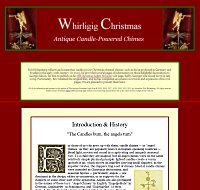|
Angel Chimes
A brief survey

For
those of us who grew up with them, candle chimes are the
distillation of Christmas, an utterly seasonal blend of light,
motion, and sound. They belong to a purely domestic and
old-fashioned type of Christmas festival, one that emphasizes a dark
room over a brightly lit one (to appreciate the dancing interplay of
light and shadow); calm over activity (so that stray air currents
shouldn’t disrupt the workings); and quiet over noise (the better to
hear the delicate chimes). Darkness, stillness, silence: all
inescapable aspects of the northern winter, and it is therefore not
surprising that candle chimes should be such an enduring tradition
in German, Scandinavian and North American Christmas celebrations.
All candle chimes are
constructed on same simple principle: lighted candles create a warm updraft of air, which moves an impeller carrying small
clappers; as the impeller rotates, the clappers ring a set of
chimes. Most of these toys were intended as Christmas decorations,
and angel figures are thus very often a key part of the design,
either as decoration, or as supports for the clappers or some other
part of the apparatus.
warm updraft of air, which moves an impeller carrying small
clappers; as the impeller rotates, the clappers ring a set of
chimes. Most of these toys were intended as Christmas decorations,
and angel figures are thus very often a key part of the design,
either as decoration, or as supports for the clappers or some other
part of the apparatus.
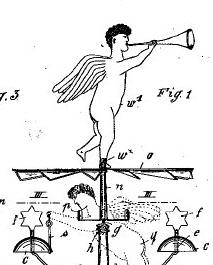 Where
there are angels, they are often shown blowing horns, the chimes
standing symbolically (if inadequately) for the noise of the
heavenly hosts trumpeting the news of the Nativity to the shepherds.
The number of candles, chimes, clappers, and angels can vary. Some
candle chimes were designed as tree toppers, some as table
decorations; some did double duty. And a few single-candle chimes
were designed as ornaments, meant to hang in the boughs of a
Christmas tree. Where
there are angels, they are often shown blowing horns, the chimes
standing symbolically (if inadequately) for the noise of the
heavenly hosts trumpeting the news of the Nativity to the shepherds.
The number of candles, chimes, clappers, and angels can vary. Some
candle chimes were designed as tree toppers, some as table
decorations; some did double duty. And a few single-candle chimes
were designed as ornaments, meant to hang in the boughs of a
Christmas tree.
Although German in
origin, these musical toys have been popular throughout Europe and
America for over a hundred years, sold in German-speaking countries as
“Engelsgeläute” (angel chimes), “Weihnachtsgeläute” (Christmas
chimes), or “Christbaumgeläute” (Christmas tree chimes); in
Scandinavia as “Änglaspelet;” and in Finland as “Enkelikellot” (a
term derived directly from the German “Engelgeläute”). Though less
common in southern climates, we also find “los angelitos” in
Spanish-speaking countries, and “carillon des anges” in France. In
America they have been marketed most commonly as “Angel Chimes” (a
literal translation of the German “Engelgeläute”), but sometimes
more fancifully as “Whispering Angels,” or “Angel-Abra.”
for over a hundred years, sold in German-speaking countries as
“Engelsgeläute” (angel chimes), “Weihnachtsgeläute” (Christmas
chimes), or “Christbaumgeläute” (Christmas tree chimes); in
Scandinavia as “Änglaspelet;” and in Finland as “Enkelikellot” (a
term derived directly from the German “Engelgeläute”). Though less
common in southern climates, we also find “los angelitos” in
Spanish-speaking countries, and “carillon des anges” in France. In
America they have been marketed most commonly as “Angel Chimes” (a
literal translation of the German “Engelgeläute”), but sometimes
more fancifully as “Whispering Angels,” or “Angel-Abra.”
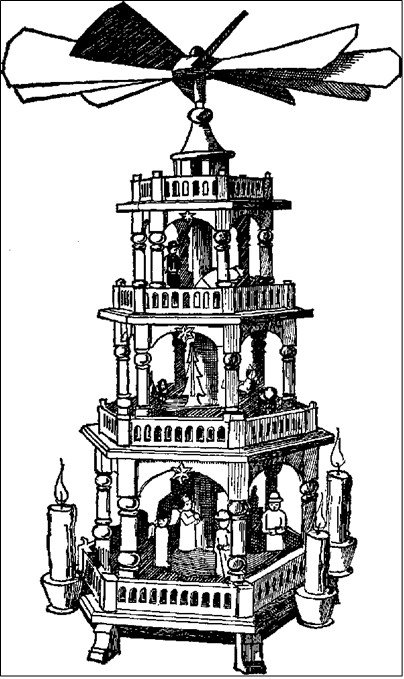 This
survey does not deal with the "pyramide"-type of revolving Christmas
toy. Although they probably
have the same ancestor, they are separate species: the “pyramide” is generally made (often hand-made) of
wood, not mass-produced from metal, and is classed with the carved
wooden toys produced in the Erzgebirge region of Germany; it may or
may not incorporate chimes; and angels are not necessarily a key
element of the design. In addition, the "pyramide" was less popular
in America than the metal candle chimes: seldom (as far as I know)
manufactured in the US, and imported less often. (And finally: I
don’t have any in my collection!) This
survey does not deal with the "pyramide"-type of revolving Christmas
toy. Although they probably
have the same ancestor, they are separate species: the “pyramide” is generally made (often hand-made) of
wood, not mass-produced from metal, and is classed with the carved
wooden toys produced in the Erzgebirge region of Germany; it may or
may not incorporate chimes; and angels are not necessarily a key
element of the design. In addition, the "pyramide" was less popular
in America than the metal candle chimes: seldom (as far as I know)
manufactured in the US, and imported less often. (And finally: I
don’t have any in my collection!)
Unless otherwise noted,
the illustrations are from the author’s own collection. This
assembly is only about five years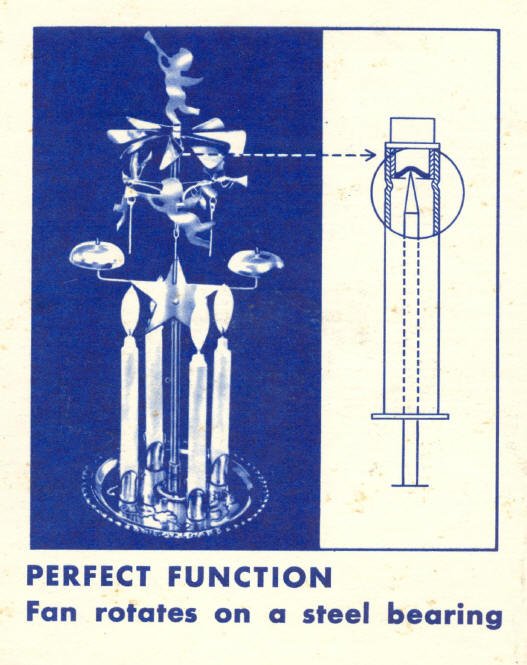 old, so the information given here is necessarily preliminary, and
therefore somewhat sketchy, drawn mainly from what the collector has
seen with his own eyes. It is only occasionally supported by
research in books (mostly German, in which the collector is NOT
fluent), in useful websites like this one, and those of the various
national patent agencies. Needless to say, the author welcomes
comments, additions and corrections, particularly information on
manufacturers and variant models, as well as examples of marketing
from contemporary catalogs.
old, so the information given here is necessarily preliminary, and
therefore somewhat sketchy, drawn mainly from what the collector has
seen with his own eyes. It is only occasionally supported by
research in books (mostly German, in which the collector is NOT
fluent), in useful websites like this one, and those of the various
national patent agencies. Needless to say, the author welcomes
comments, additions and corrections, particularly information on
manufacturers and variant models, as well as examples of marketing
from contemporary catalogs.
My thanks to site owner
George Nelson, not only for allowing me to share this fascinating
corner of pre- (or anti-?) electric Christmas lighting on his
website, but also for his boundless enthusiasm — which rivals my own
— and his impressive technical know-how, without which these images
would have remained in my digital camera.
Eric Holzenberg
boreas58@verizon.net
|
General notes
for the collector
Dimensions:
Dimensions are given in centimeters, height (usually to the top of
the tallest element on the chime) times width (usually the width of
the chime supports); the diameter of circular bases, or the width
times length of rectangular bases, are also given where appropriate.
Condition: No condition rating has been applied to the items in
this collection, but others may want to consult
one of the standard systems for judging toy condition, such as this one at
PGTOYS. Metal candle chimes were usually seasonal items, used
briefly at Advent through Christmas, and then packed away for the
rest of the year; and although generally manufactured by toy-makers,
they were not handled much by children. Compared to other antique
metal toys, a surprising number of candle chimes survive in good
condition, with original packaging, and the collector of course will
prefer these examples. A collectible chime will retain its original
finish. For the early German chimes, nickel-plated, gilded or
lithographed elements should be bright, clean and unworn, without
scratches or rust. (You can prevent scratches and other damage by
packing chime elements in acid-free tissue paper.) In Germany it is
apparently relatively common to re-plate worn elements, but original
condition is generally preferable. For the later
Swedish-pattern brass chimes, the state of the surface is a matter
of taste: personally I prefer not to polish away the patina of age.
A collectible chime will have all its bits, although it can be
difficult to tell what a “complete” chime ought to consist of.
Commonly missing from early German chimes, for instance, are the
little silver or gilt stars which sit atop the chimes; other
casualties are angel toppers, bell-clappers, and candle-holders.
Original packaging and
instructions can be crucial in determining whether a chime is
complete: the cover picture will usually show the fully-assembled
chime, with all its elements; and if there are assembly instructions, these will
often include a parts list. Even where the packaging and
instructions are not strictly necessary for assembly or inventory,
they are still desirable both philosophically — the chime is not
really ‘complete’ without them — and practically, since a chime with
original packaging (particularly in good, unworn condition) and
instructions is worth much more than a chime that lacks these
elements.
Care
and maintenance: Fire and oily soot residue are the greatest
enemies of candle chimes. Make sure that the candleholders don’t sit
too near or directly below painted or plated elements: soot build-up
and and burn marks are common (and avoidable) condition problems in
candle chimes. Gentle cleaning at the end of each season with a
small amount of grease-cutting household cleaner like Formula 409 or
Fantastik can help keep soot build-up under control. (Don’t use
harsher commercial cleaners or degreasers, since these can damage
lithographed and painted finishes.) Don’t allow the candles to burn
down completely: digging puddles of wax out of the candleholders
will eventually damage them. A number of things can prevent a chime
from functioning. Make sure that the spindle which carries the
impeller is absolutely vertical: a lean of just a few degrees can
cause problems. A spindle that is worn or blunted will also keep the
chime from running: it can be sharpened with a fine metal file.
Check that the blades of the impeller are all at a uniform angle of
about 45 degrees. Note that you may have to adjust the chime holders
so that the clappers just brush the chimes: bend them too far in,
and the clappers will slow and eventually stop the impeller; bend
them too far out, and the clappers won’t strike at all. Finally,
make sure that the chime is not sitting in a draft: the hot air
currents must rise straight up in order to move the impeller.
|
|
History
 It is not clear when
and where the first candle chime was made. The makers of some
1950s-era Swedish angel chimes asserted that their product was “an
exact replica of a beautiful old Swedish original,” but I have not
been able to substantiate that claim. At about the same time the
American firm of Holt Howard was putting forward an even more
dubious parentage for its “Angel-abra”: “Many years ago in the
kingdom of Bavaria, a devoted troubadour fashioned the first Angel-abra.
Presented to the beautiful, young Princess Anna along with the
lavish gifts of Knights and Nobles, the troubadour’s offering
captured the fancy of the happy Princess and became her most prized
possession.” Although the other details are pure invention, this
fanciful description is in the ballpark when it come to the probable
place of origin of the first candle chimes. It is not clear when
and where the first candle chime was made. The makers of some
1950s-era Swedish angel chimes asserted that their product was “an
exact replica of a beautiful old Swedish original,” but I have not
been able to substantiate that claim. At about the same time the
American firm of Holt Howard was putting forward an even more
dubious parentage for its “Angel-abra”: “Many years ago in the
kingdom of Bavaria, a devoted troubadour fashioned the first Angel-abra.
Presented to the beautiful, young Princess Anna along with the
lavish gifts of Knights and Nobles, the troubadour’s offering
captured the fancy of the happy Princess and became her most prized
possession.” Although the other details are pure invention, this
fanciful description is in the ballpark when it come to the probable
place of origin of the first candle chimes.
Most of the scant
historical evidence on the origins of these toys seems to point to
Germany. One likely ancestor, dating from the late middle ages, was
the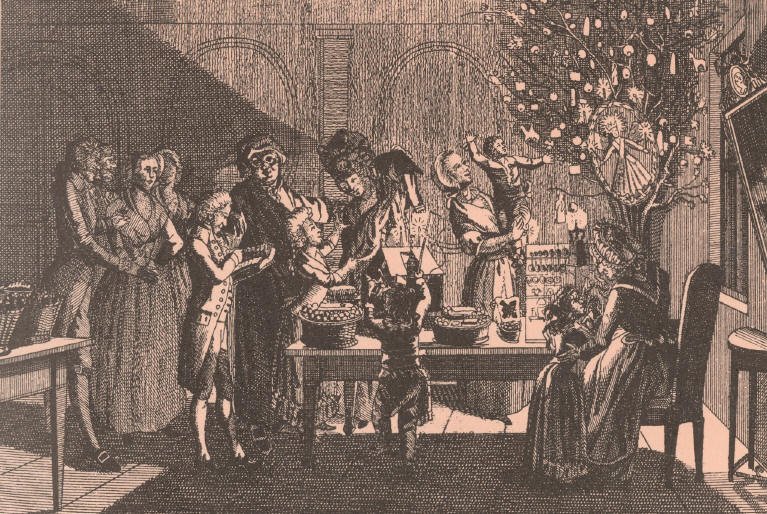 wooden pyramid set up at Christmas in some German homes. The
triangular shape of this “pyramide” represented the Trinity, and it
was often decorated with candles (symbolizing Christ as the light of
the world), the Star of Bethlehem, and other ornaments. This custom
eventually merged with an even more ancient pagan practice of
bringing evergreen trees indoors at the winter solstice. wooden pyramid set up at Christmas in some German homes. The
triangular shape of this “pyramide” represented the Trinity, and it
was often decorated with candles (symbolizing Christ as the light of
the world), the Star of Bethlehem, and other ornaments. This custom
eventually merged with an even more ancient pagan practice of
bringing evergreen trees indoors at the winter solstice.
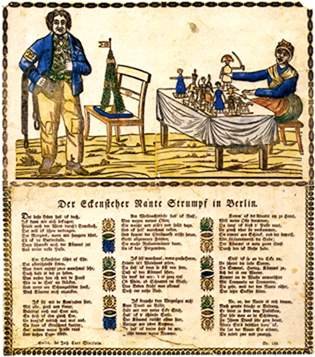 Sanitized
and Christianized by Martin Luther and others, the result was the
decorated, candle-lit Christmas tree. (Shown to the right is a German
print from 1800 entitled “The First Sight of the Christmas Tree,” by
Josef Kelbner). But the ancient idea of the decorated wooden pyramid
is known to have survived well into modern times (shown above left
is a mid-nineteenth-century print illustrating a German Weihnachtspyramide) and it may very well have mutated, first into
the hand-made candle-powered revolving wooden “pyramide” toys of the
Erzgebirge region; and later into the sturdier, mass-produced tin
and brass toys generally marketed as “angel chimes.” Sanitized
and Christianized by Martin Luther and others, the result was the
decorated, candle-lit Christmas tree. (Shown to the right is a German
print from 1800 entitled “The First Sight of the Christmas Tree,” by
Josef Kelbner). But the ancient idea of the decorated wooden pyramid
is known to have survived well into modern times (shown above left
is a mid-nineteenth-century print illustrating a German Weihnachtspyramide) and it may very well have mutated, first into
the hand-made candle-powered revolving wooden “pyramide” toys of the
Erzgebirge region; and later into the sturdier, mass-produced tin
and brass toys generally marketed as “angel chimes.”
Whatever their
ancestry, we should look, not to Bavaria, but to the Westphalian
manufacturing city of Solingen, for the earliest mass-production of
metal candle-powered chimes. |
|

